PVP01_0816800 Rh5 interacting protein, putative (RIPR)
Disruptability [+]
| Species | Disruptability | Reference | Submitter | |
|---|---|---|---|---|
| P. berghei ANKA |
Refractory |
PlasmoGEM (Barseq) | PlasmoGEM | |
| P. falciparum 3D7 |
Refractory |
21909261 | Theo Sanderson, Wellcome Trust Sanger Institute | |
| P. falciparum 3D7 |
Possible |
USF piggyBac screen (Insert. mut.) | USF PiggyBac Screen | |
Mutant phenotypes [+]
None reported yet. Please press the '+' button above to add one.Imaging data (from Malaria Metabolic Pathways)
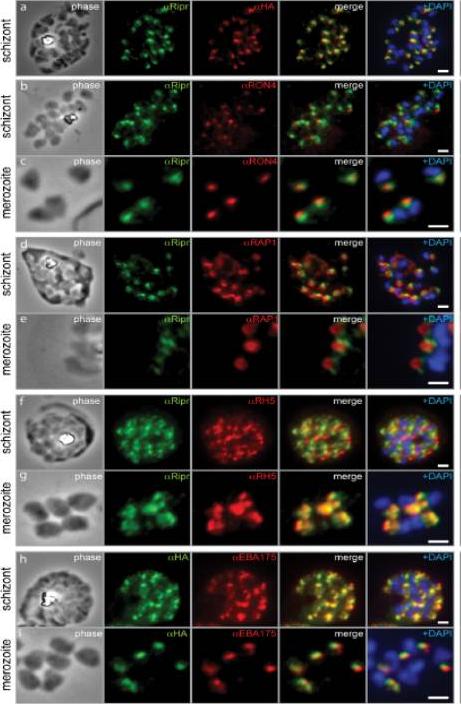
PfRipr localizes to the apical end of merozoites. a) Rabbit polyclonal anti-PfRip antibody (anti-PfRipr/1) recognizes HA-tagged PfRiprHA. b) PfRipr does not co-localize with the rhoptry neck protein RON4 in schizonts. c) PfRipr does not co-localize with the rhoptry neck protein RON4 in merozoites. d) PfRipr does not co-localize with the rhoptry bulb protein, RAP1 in schizonts. e) PfRipr does not co-localize with the rhoptry bulb protein, RAP1 in merozoites. f) PfRipr partially co-localizes with PfRh5 in the schizonts. g) PfRipr mainly co-localizes with PfRh5 in purified merozoites. h) PfRipr co-localizes with the micronemal marker, EBA175, in schizonts. i) PfRipr does not co-localize with the micronemal marker, EBA175, in merozoites.Chen L, Lopaticki S, Riglar DT, Dekiwadia C, Uboldi AD, Tham WH, O'Neill MT, Richard D, Baum J, Ralph SA, Cowman AF. An EGF-like protein forms a complex with PfRh5 and is required for invasion of human erythrocytes by Plasmodium falciparum. PLoS Pathog. 2011 7(9):e1002199.
See original on MMP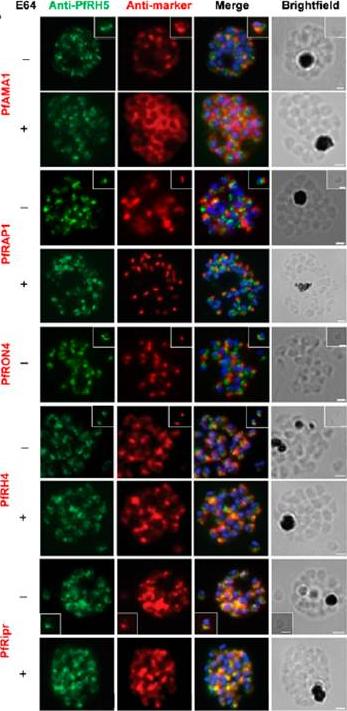
Localization of PfRH5 was assessed by indirect IFA using anti-PfRH5 polyclonal rabbit serum (green). Fixed and permeabilized schizonts with (+) or without (2) E64 treatment or free merozoites (inset) of 3D7 clone P. falciparum were costained with mouse Abs (red) to mark various organelles: PfAMA1 polyclonal (microneme), PfRAP1 mAb (rhoptry body), or PfRON4 mAb (rhoptry neck); or polyclonal mouse serum against further Ags: PfRH4 and PfRipr. Figures show the merge of the dual staining Abs and nuclei stained with DAPI (blue), as well as the brightfield view. Scale bars, 1 mm. anti-PfRH5 rabbit Abs (8) do not colocalize with conventional markers of the rhoptry bulb, rhoptry neck, or micronemes (PfRAP1, PfRON4, and PfAMA1, respectively) in permeabilized schizonts or free merozoites of 3D7 clone P. falciparum parasites. Minimal colocalization in schizonts with PfRH2a/b (data not shown) and also with PfRH4, described as a marker of the rhoptry tip, but significant colocalization with PfRipr in merozoites and late-stage schizonts, especially following treatment with the cysteine protease inhibitor E64, which prevents merozoite release by inhibiting schizont rupture. Impossible to detect PfRH5 on the merozoite surface in any assay, with staining only successful following permeabilization .Douglas AD, Williams AR, Knuepfer E, Illingworth JJ, Furze JM, Crosnier C, Choudhary P, Bustamante LY, Zakutansky SE, Awuah DK, Alanine DG, Theron M, Worth A, Shimkets R, Rayner JC, Holder AA, Wright GJ, Draper SJ. Neutralization of Plasmodium falciparum Merozoites by Antibodies against PfRH5. J Immunol. 2014 192(1):245-58.
See original on MMP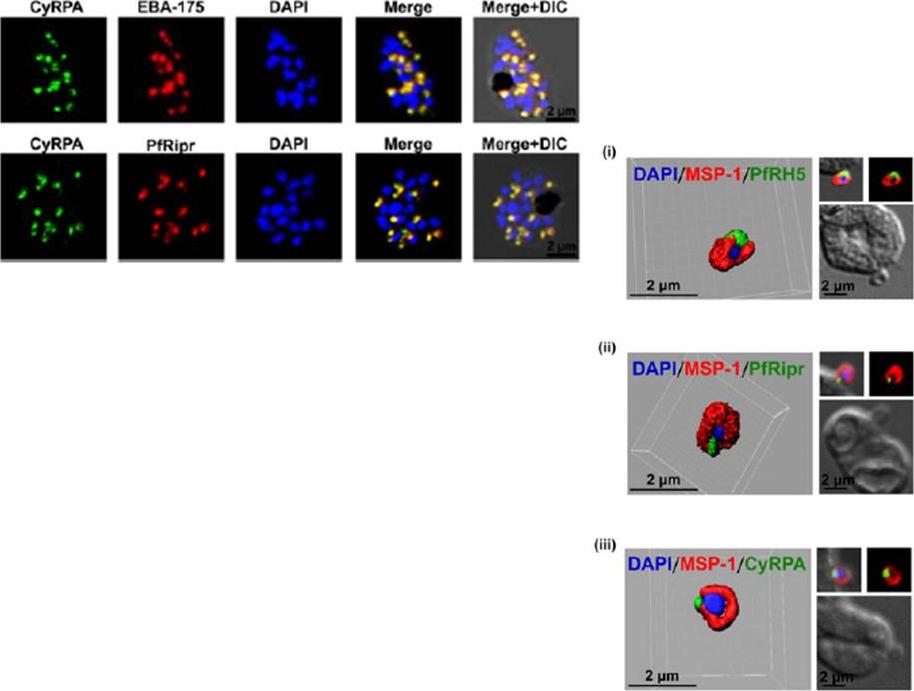
Left: Immunofluorescence microscopy detected CyRPA to colocalize with micronemal proteins (EBA-175, PfRipr). (Scale bar, 2 μm.)Right: PfRH5/PfRipr/CyRPA complex is GPI-anchored to the merozoite surface. (A) 3D reconstruction of IFA z-stacks during merozoite invasion, coimmunostained with MSP-1 detected PfRH5, PfRipr, and CyRPA at the apical end of the merozoite surface. In the 3D images, the γ settings were altered for visual representation only,Reddy KS, Amlabu E, Pandey AK, Mitra P, Chauhan VS, Gaur D. Multiprotein complex between the GPI-anchored CyRPA with PfRH5 and PfRipr is crucial for Plasmodium falciparum erythrocyte invasion. Proc Natl Acad Sci U S A. 2015 Jan 12.
See original on MMP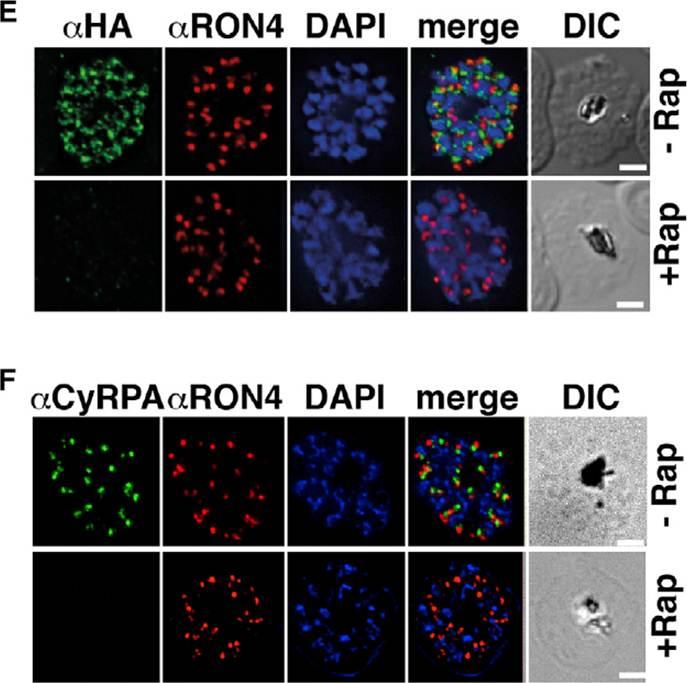
Previous attempts to disrupt PfRipr and CyRPA in P. falciparum have not been successful, suggesting their function is essential. To understand their function, we constructed P. falciparum lines in which pfripr and cyrpa could be conditionally deleted using dimerizable Cre recombinase (DiCre) by generating RiprloxCre and CyRPAloxCre. The absence of PfRipr and CyRPA expression was analyzed by immunofluorescence, and a significant proportion of the populations showed no detectable expression (E and F). These results show that rapamycin-treated RiprloxCre and CyRPAloxCre have substantially decreased expression of PfRipr and CyRPA, respectively. The decrease in expression had no effect on expression and localization of other proteins involved in merozoite invasion.Volz JC, Yap A, Sisquella X, Thompson JK, Lim NT, Whitehead LW, Chen L, Lampe M, Tham WH, Wilson D, Nebl T, Marapana D, Triglia T, Wong W, Rogers KL, Cowman AF. Essential Role of the PfRh5/PfRipr/CyRPA Complex during Plasmodium falciparum Invasion of Erythrocytes. Cell Host Microbe. 2016 Jun 30 [Epub ahead of print]
See original on MMP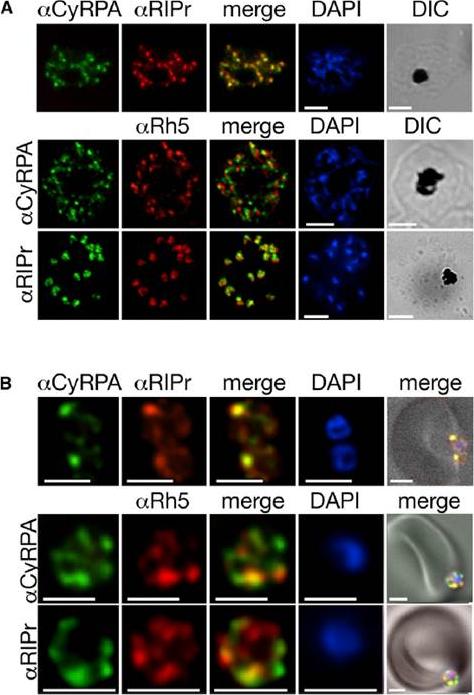
Subcellular Localization of PfRipr, CyRPA, and PfRh5 in Schizonts and Invading Merozoites(A) Top panel: Overlay of CyRPA (green) and PfRipr (red) with DAPI and DIC fields. Middle panel, overlay of CyRPA (green) and PfRh5 (red) with DAPI andDIC fields. Lower panel, overlay of PfRipr (green) and PfRh5 (red) with DAPI and DIC images.(B) Merozoites were mixed with erythrocytes and CyRPA, PfRipr, and PfRh5 visualized. Top panel, colocalization of CyRPA (green) and PfRipr (red) with DAPI and DIC images. Two merozoites invading a single erythrocyte. Middle panel, overlay of CyRPA (green) and PfRh5 (red) with DAPI and DIC fields with a single merozoite. Lower panel, overlay of PfRipr (green) and PfRh5 (red) withDAPI and DIC images. White bar indicates 5 mm.Volz JC, Yap A, Sisquella X, Thompson JK, Lim NT, Whitehead LW, Chen L, Lampe M, Tham WH, Wilson D, Nebl T, Marapana D, Triglia T, Wong W, Rogers KL, Cowman AF. Essential Role of the PfRh5/PfRipr/CyRPA Complex during Plasmodium falciparum Invasion of Erythrocytes. Cell Host Microbe. 2016 Jun 30 [Epub ahead of print] PMID: 27374406
See original on MMP
Subcellular Localization of PfRipr, CyRPA, and PfRh5 in Schizonts and Invading Merozoites(A) Top panel: Overlay of CyRPA (green) and PfRipr (red) with DAPI and DIC fields. Middle panel, overlay of CyRPA (green) and PfRh5 (red) with DAPI andDIC fields. Lower panel, overlay of PfRipr (green) and PfRh5 (red) with DAPI and DIC images.(B) Merozoites were mixed with erythrocytes and CyRPA, PfRipr, and PfRh5 visualized. Top panel, colocalization of CyRPA (green) and PfRipr (red) with DAPI and DIC images. Two merozoites invading a single erythrocyte. Middle panel, overlay of CyRPA (green) and PfRh5 (red) with DAPI and DIC fields with a single merozoite. Lower panel, overlay of PfRipr (green) and PfRh5 (red) withDAPI and DIC images. White bar indicates 5 mm.Volz JC, Yap A, Sisquella X, Thompson JK, Lim NT, Whitehead LW, Chen L, Lampe M, Tham WH, Wilson D, Nebl T, Marapana D, Triglia T, Wong W, Rogers KL, Cowman AF. Essential Role of the PfRh5/PfRipr/CyRPA Complex during Plasmodium falciparum Invasion of Erythrocytes. Cell Host Microbe. 2016 Jun 30 [Epub ahead of print] PMID: 27374406
See original on MMPMore information
| PlasmoDB | PVP01_0816800 |
| GeneDB | PVP01_0816800 |
| Malaria Metabolic Pathways | Localisation images Pathways mapped to |
| Previous ID(s) | null |
| Orthologs | PBANKA_1215100 , PCHAS_1215800 , PF3D7_0323400 , PVX_095055 , PY17X_1218300 |
| Google Scholar | Search for all mentions of this gene |